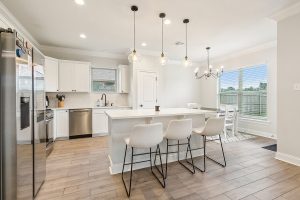In July, existing home sales saw their first rise in five months, according to the National Association of Realtors (NAR). A 1.3% increase in sales brought the seasonally adjusted annual rate to 3.95 million units, marking a potential shift in the market as inventory levels improved slightly and mortgage rates began to decline. However, despite this increase, sales remain sluggish, and low inventory continues to drive up home prices. With mortgage rates expected to ease further in the coming months, we could see increased buyer activity and improved affordability.
Homeowners holding onto lower-rate mortgages have contributed to limited inventory, as many are opting not to trade their existing mortgage for new loans at higher rates. This trend has pushed home prices higher, keeping supply constrained. The NAR expects that, as mortgage rates gradually decrease, demand will rise and more homeowners will be willing to sell. However, this outlook is largely dependent on broader economic indicators such as inflation, employment data, and potential rate adjustments by the Federal Reserve.
July Housing Market Highlights
July’s 1.3% sales increase marks a break from four months of declines, though sales are still down 2.5% compared to the previous year. First-time buyers made up 29% of transactions, unchanged from June but down from 30% in July 2023. Inventory levels rose marginally, from 1.32 million units in June to 1.33 million units in July, representing a 19.8% year-over-year increase. Despite this, inventory remains below the 4.5 to 6 months’ supply that typically indicates a balanced market. Currently, July’s unsold inventory sits at a 4.0-month supply, up from last year’s 3.3-months but slightly down from June.
The median sales price of existing homes also saw a rise, climbing 4.2% year-over-year to $422,600, marking the 13th consecutive month of price increases. Condominium and co-op prices followed a similar trend, increasing 2.7% from a year ago to $367,500. As inventory improves, this rate of price growth is expected to slow.
Regionally, existing home sales varied. The Northeast saw a 4.3% increase, the South and West rose 1.1% and 1.4% respectively, while sales in the Midwest remained unchanged. Year-over-year, sales increased in the Northeast (2.1%) and West (1.4%) but fell in the Midwest (-5.2%) and South (-3.8%).
Market Trends and Outlook
All-cash sales made up 27% of transactions in July, down slightly from June but up from a year ago, highlighting that cash buyers remain relatively unaffected by interest rate fluctuations. Homes typically remained on the market for 24 days in July, up from 22 days in June and 20 days a year earlier, reflecting a cooling in market demand.
The NAR’s Pending Home Sales Index (PHSI), a forward-looking indicator based on signed contracts, rose to 74.3 in July, up from 70.9 in June, as inventory improved. However, pending home sales were still 2.6% lower compared to the previous year, indicating that market conditions remain challenging for both buyers and sellers. With the potential for further declines in mortgage rates, housing activity may pick up in the months ahead, helping to balance rising prices and persistent inventory shortages.

